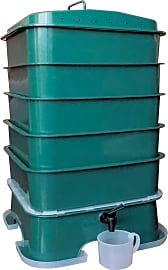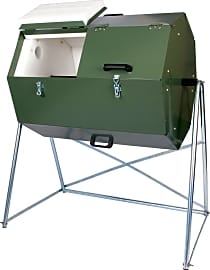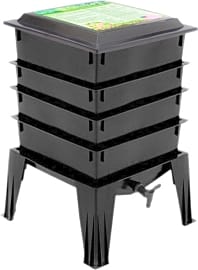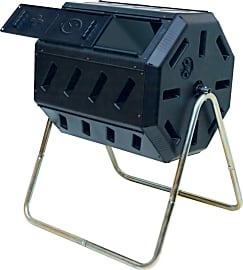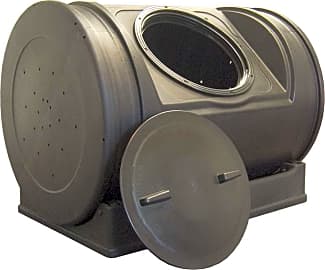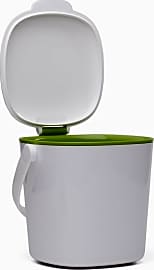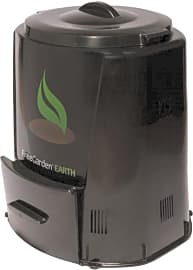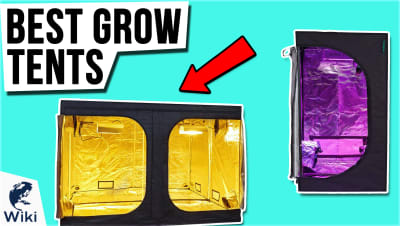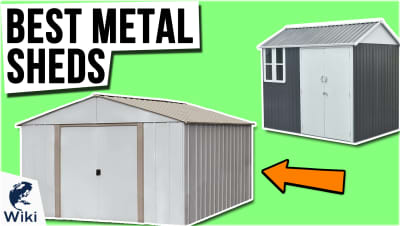The 10 Best Composting Bins

This wiki has been updated 39 times since it was first published in April of 2015. Nourish your plants while being environmentally conscientious and reducing the amount of trash you create by collecting your scraps in a composting bin. Over time, your coffee grounds, egg shells, and vegetable peels will become nutrient-rich fertilizer. We've selected composters with a range of capacities, designs, and speeds of decomposition, so you can pick just the right one for your home. When users buy our independently chosen editorial recommendations, we may earn commissions to help fund the Wiki.
Editor's Notes
July 15, 2021:
We made just a single change to the Wiki this time around, but it was an important one. Our previous #1 from Envirocycle is no longer available, so we've replaced it with the Miracle Gro DC140. From a longstanding name in gardening products, this rock-solid option has two chambers to maximize efficiency and ensure that nothing makes it to your garden without being completely decomposed.
July 20, 2020:
The newly added VermiHut Plus is a popular option among those who practice vermicomposting, or keeping worms that turn your food scraps into rich fertilizer. Like the Worm Factory 360, this model contains a series of trays and features a drain spigot, but it also sports a convenient handle on top that provides you with easy access. Its tightly fitting lid also ensures good moisture control while keeping out fruit flies and other pests. It replaces the compact Chef'n Eco Crock, which provides too limited of a capacity for many busy households. The Envirocycle E20C remains in our number one spot, as its quality and design are tough to beat. While it’s made of hard-wearing materials, its low profile helps it to look unobtrusive in any backyard setting. You can choose a neutral black one, or one that’s a bright pink to suit your personality. It rotates easily and is made of food-grade, rust-free, and UV-resistant materials.
For a couple of low-maintenance choices, look to the Jora Tumbler JK270 and the Yimby Tumbler, which are designed in the convenient tumbler style that eliminates the need for your having to manually stir the contents. Each contains two chambers, so you can designate one for fresh waste and the other for materials that are further along in the process. Both are situated on sturdy stands, which makes them easy to turn and also keeps them off the ground and within reach of many critters. For an indoor choice that will look great on virtually any countertop, check out the Utopia Kitchen 0051. It can contain several days’ worth of waste at a time, and its charcoal filters help prevent unpleasant odors from forming. This highly portable choice features a comfortable carrying handle, and its stainless steel build is resistant to scratches and chips.
If you’re new to composting, know that all compost piles need three components: Brown materials like dead leaves, branches and twigs, green materials like grass clippings and vegetable and fruit scraps, and water. Other compostable materials include eggshells, coffee grounds, tea bags, nut shells, cardboard, paper, shredded newspaper, fireplace ashes, wood chips, dryer lint, and hair and fur. Items that are not safe to compost include coal or charcoal ash, dairy products, fats and grease, meat or fish scraps, and pet waste. Some of these materials can produce problems like odors and the attraction of rodents and flies. Since compost can become a breeding ground for potentially dangerous pathogens, always wear gloves when handling compost, as well as a dust mask to avoid inhaling any dangerous spores that can becoming airborne when you’re turning the materials.
April 15, 2019:
We included both indoor countertop choices and large outdoor models for all stages of the composting process. For those who compost their kitchen scraps, a collection container is necessary for controlling smells and keeping out pests. The Utopia Kitchen 0051 is the top countertop choice for controlling smells with its charcoal filter and for it's attractive design that cooks will be happy to leave out, thus ensuring consistent usage.
When evaluating the outdoor compost bins we looked for models that provided adequate aeration (especially in the non-tumbling choices) and tough enough construction to stand up to pests. The Envirocycle E20C continues to be the top choice for virtually indestructible design and the ease of turning.
Special Honors
Living Composter This sleek and curving biomorphic worm house is more stylish than most alternatives that resemble garbage bins. It’s made of white recycled plastic with a cork lid, and keeps odors locked in. Just insert your grain foods, tea bags, or fruit and vegetable peelings into the top opening, and the worms inside will consume at least half of their weight of scraps per day. This can translate to the processing of more than two pounds of food per week. In addition to the vessel and the lid, it also comes with a fertilizer scoop, a sprayer, and a probe for moisture, light, and pH levels. All you’ll need to add are some sawdust and worms. uncommongoods.com
Choosing The Right Compost Bin
Make sure to consider a unit that features a charcoal filter to reduce odors.
Composting is eco friendly, economically savvy, and, done properly, can be relatively easy, too. But proper composting requires a fair amount of patience and effort at the outset; getting your compost bin to start working takes many days or even weeks of initial care. Composting can also be relatively messy work, complete with odors and potential spills, not to mention the attraction of flies, raccoons, and other potential pests.
When you hear the words "compost bin," you might think of a cube shaped box that sits behind a house or in an alley near trash cans. You might also picture a compact can that perches atop the kitchen counter. Or perhaps you think of a large drum that can be rotated about, tossing the material within it.
If you thought of any of these items, you're right: all are compost bins. And they don't represent the entire array of options at your disposal. Before choosing the right bin for your home, first take a few moments to consider these factors.
Once established, a compost bin can be largely odor free, essentially self sustaining, and can yield you nutrient rich soil perfect for planting edible crops or flowers or for rejuvenating the soil of your lawn of landscaping. To establish that proper compost system, make sure you're honest with yourself about your level of commitment.
There's nothing wrong with merely maintaining a small countertop compost bin for the production of a bit of fertilizing soil you will use in some planters. Several compact compost bin options are at your disposal, a few of which actually look good enough to add style and function to your kitchen. Make sure to consider a unit that features a charcoal filter to reduce odors.
Don't burden yourself with a large rotating compost bin if you're unlikely to actually fill, moisten, and turn the unit often enough to justify its purchase. However, if you have some space available on your property and you think you will indeed stick with a composting routine, there is no better way to turn food scraps and yard trimmings into useful material than by using a large, well made compost bin.
Larger compost bins are more effort at the outset, but once established they require only a few minutes of work each week, at least until a batch of compost is ready for removal and use. Rotating compost bins and multi-level tiered bins each require specific maintenance that comes with a bit of a learning curve, but once you have their use mastered, they are efficient and reliable in their production of an organic, safe alternative to chemical based fertilizers.
Proper Compost 101
Establishing proper compost is all about balance. That balance comes primarily in the form of relatively equal parts of carbon-rich and nitrogen-rich materials coexisting in your compost bin. The easy way to remember this need for balance is to think of it as a mix between "brown" and "green" materials.
Too dry, and it will not properly break down; too wet, and compost will turn into a muddy mass that precludes decomposition and will be hard to spread.
Brown materials, which supply the needed carbon, include everything from dried leaves to pine needles to straw to shredded paper (safe so long as it is free of dye and chemicals). Green materials included everything from fruit and vegetable scraps to green weeds or leaves to wilting flowers to green grass trimmings. You need to not only add brown and green materials in roughly equal balance, but your need to mix them within your compost bin. This means rotating a bin of possible, or else turning the compostable material using a shovel or rake (or just a large spoon, depending on the type and size of bin you use).
The next balancing act for maintaining a compost bin is the need for air and water. Proper compost needs both, but can be damaged by too much of either. When it comes to air (the oxygen being the operative) make sure your compost has constant access to a bit of air, as with slots or holes in the side of a bin, or else open the lid of a closed bin at least once daily. With water, the key is to keep the compost moist. Too dry, and it will not properly break down; too wet, and compost will turn into a muddy mass that precludes decomposition and will be hard to spread.
A Few Compost "Dos" And "Don'ts"
Establishing a great compost system takes some work but is rewarding. Ruining a batch of compost can be frightfully easy and disheartening. So here are some mistakes and pitfalls to avoid at all costs and a few ideas to run with.
Traces of grain waste are fine, such as the last bit of rice in a stir fry meals leftovers or a crust or two from a sandwich.
You should not compost most grains or rices: cooked rice and breads can attract pests, and they tend to quickly grow mold and break down at different speeds than most other materials. Traces of grain waste are fine, such as the last bit of rice in a stir fry meals leftovers or a crust or two from a sandwich.
Never compost meat or dairy products. They will smell awful and can contain harmful bacteria. They also attract pests.
Don't pack down your compost. It may be tempting to tamp down that pile so you can fit in more scraps or trimmings, but compacting the compostable material will impair the decomposition process.
Do add worms to your compost bin, as they can speed up the process and help your bin produce quality compost. Worms should only be used in larger, outdoor bins though.
It's also a good idea to have another area to store "finished" compost. As soon as a batch of food scraps and brown waste has broken down into compost, you should get it out of your bin and start a new cycle.


